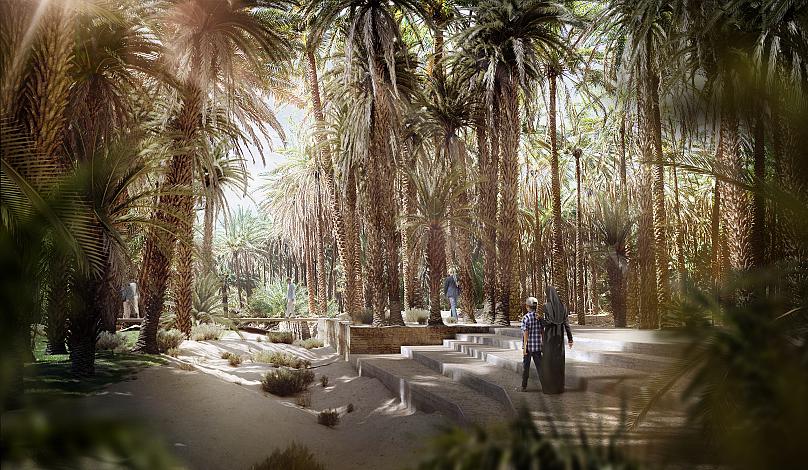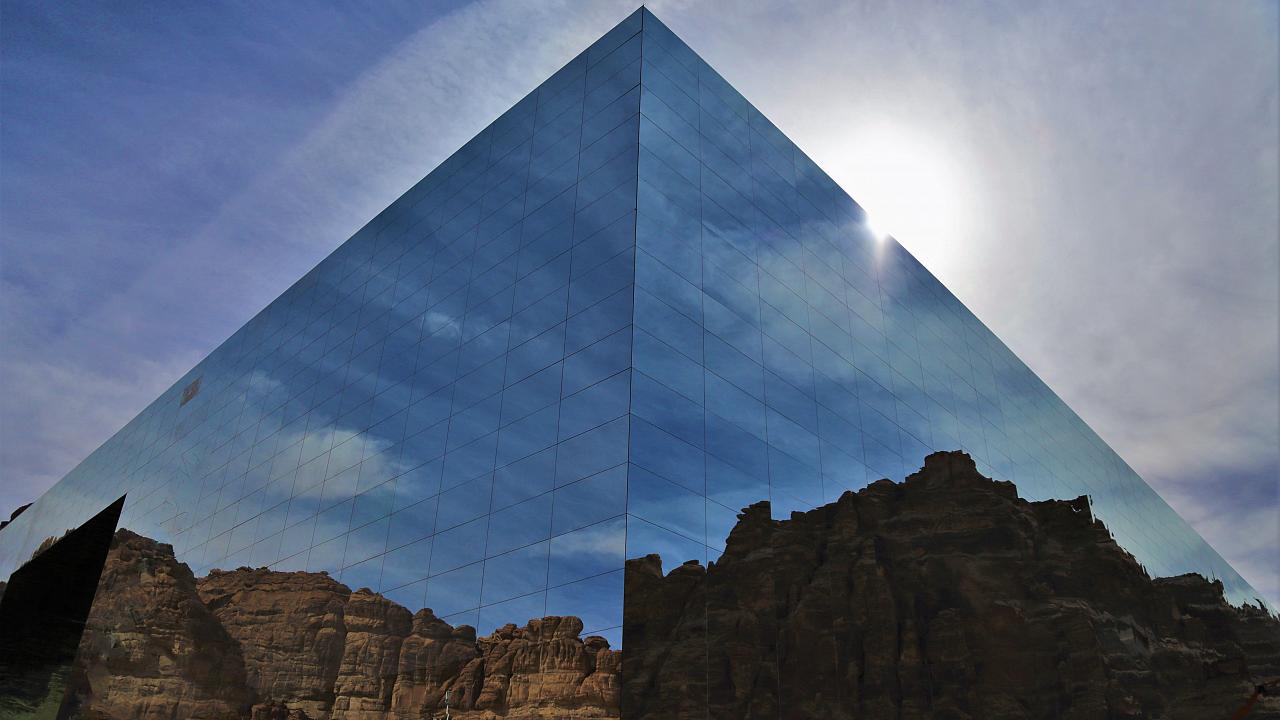Meraya Concert Hall is a real achievement of engineering art. This is the largest mirrored house in the world. However, it fits perfectly into the surrounding desert landscape. It is almost impossible to notice where the sandstone rocks end and the walls of the concert hall begin.
The construction of this building is only a small part of the changes that Al-Ula, one of the regions of Saudi Arabia, is experiencing, which is becoming an attractive place for foreign tourists. As part of the ambitious restoration project, Al-Ulu is planned to become a unique destination for fans of art, culture, historical heritage and nature from around the world.
If you are planning a trip, here you will find everything you need to know about this magical place.
Where is Al Ula?
In northwestern Saudi Arabia, 200 km from the Red Sea, on the ancient Incense Route – a trade route that connected the Arabian Peninsula with the Mediterranean. For centuries, Al-Ula has been a geographical and cultural crossroads, a place for meetings and exchanges. Travelers from all over the world flocked here, and in 2020 they reopened this route. According to the large-scale restoration plan, Al-Ulu will be visited by 2 million guests by 2035, making it the world’s largest living museum – a unique global destination for tourists interested in culture, historical heritage and nature.
Where is “another Peter”?
Through this vast desert area of half an area of Denmark stretched a flowering valley, which are scattered majestic sandstone cliffs and historical monuments, which are thousands of years old.
The most famous of these are located in the ancient city of Hegra, which is sometimes called “another Petra”. The fact is that Peter was the capital of the Nabataean kingdom, and Hegra was in the south of this kingdom. Famous for its rock-hewn tombs, Hegra became the first UNESCO World Heritage Site in Saudi Arabia.
Al-Ula also attracts with the winding streets of the mysterious Old City, the tombs of Dedan, the unique petroglyphs of the “open-air library” Jabal Iqma and the interesting railway village of Hijaz.
Five special districts in one district
The “hospitality flaw” is the bed of a drying river that has been turned into a 20-kilometer green trail that would connect different areas.
Each district reflects its own element of Al-Ula’s history, dating back 200,000 years. Visitors can get a variety of impressions in each of the areas. They have museums, gardens, galleries, walking routes, as well as places that offer food and accommodation. Currently, eco-resorts, luxury hotels, tourist centers and the development of sandstone cliffs “canyon estates” offer guests 5,000 rooms, but by 2035 this figure will double.

The Old City of Al-Ula is a labyrinth of buildings in a flourishing oasis
The first area is the Old City of Al-Uli, located in the heart of an ancient cultural oasis. The city, which is a labyrinth of narrow streets lined with benches and houses made of clay bricks, is of great historical significance. It was inhabited from the XII century to the 1980s and then carefully restored.
The Old Town is located in an oasis, which testifies to the effectiveness of ancient methods of water management, irrigation and land use. It is a flowering and fertile area that contrasts sharply with the surrounding area.

Dedan area is an interesting archeological site
The second area is called Dedan. In the first millennium BC, the city of Dedan was the capital of the Dedan and Likhyan kingdoms. This place, surrounded by majestic red rocks, remains an active archaeological site, gradually revealing its ancient secrets to visitors.
In addition, the Institute of Kingdoms is located in Dedan – a center for archaeological research and a platform for the development of culture and knowledge, which is also working to promote the development of new frontiers. Programs for guests will include the study of methods of preservation and understanding of rock painting and petroglyphs, as well as agriculture in the prehistoric and historical period, along with sustainable development.

Jabal-Iqma is a unique open-air library
Jabal-Iqma, known as the Al-Ula Open-Air Library, is the third area to host a fascinating collection of rock inscriptions. It is believed that these petroglyphs date back to the first millennium BC. Here you can see images of animals, people and musical instruments, as well as messages, sentences and even laws written in ancient languages. In addition, guests can visit the museum of incense – do not miss if you want to learn more about the most valuable goods transported by trade.
Nabataean Horizon is a village carved into the rocks
The fourth district was named “Nabataean Horizon”. This is a bright series of rocks that precede the rocks of Hegra. The journey, in the process of which you can get acquainted with the nomadic way of life, will also introduce guests to the village carved into the rocks and the Nabataean open-air theater. In addition, there is an impressive concert hall “Meraya” – the largest mirrored house in the world.
Hegra is the crossroads of the Great Silk Road and the Incense Way
The culmination of the program will be the fifth district – the historic city of Hegra. Hegra, the “City of Silence,” flourished due to its position at the crossroads of the Great Silk Road and the Incense Path. Its monumental tombs with carved facades, carved in sandstone rocks, are a testament to the wealth and international ties of the people who once lived here. Protective structures, including the fortress, speak of the strategic importance that the city had even after the annexation of the Nabataean Empire by the Roman Empire in 105 AD.

The complex has more than 110 tombs and important archeological sites, as well as a restored Hijaz railway station.
Sustainable development is at the heart of the Al-Ula restoration project
Sustainable development and adherence to the principles of a closed-loop economy are central to Al-Ula’s development project. Passing through the ancient oasis, the channel “Wadi Hospitality” is central to plans to restore wildlife and biodiversity. Al-Ula International Airport will be connected to five districts by a tram line, which will reduce carbon emissions. This picturesque route, like the “Wadi of Hospitality”, will follow approximately the same path as the Hijaz railway line and which has been used by pilgrims for many centuries.
Currently, 60% of the oasis is abandoned due to lack of water and many years of farming by unstable methods. However, the strategy of repopulation and reversal of the desertification process by improving water management is already being implemented under the auspices of the Saudi Green Initiative. 80% of the land in this district is given to nature reserves, where many species of flora and fauna have been returned.
In addition to agricultural and water management programs, services and infrastructure based on the needs of the local community play an important role in Al-Ula’s transformation plans. It is estimated that by 2035, 38,000 new jobs will be created here, and the district’s population will grow to 130,000, which will increase the country’s GDP by 32 billion US dollars.
Reflecting Saudi Arabia’s commitment to preserving historical sites and protecting world heritage, its quest for knowledge and research, Al-Ula also demonstrates the country’s commitment to a progressive future, opening borders for international tourism and developing new spaces where locals can live and work. and engage in the development of new frontiers.

